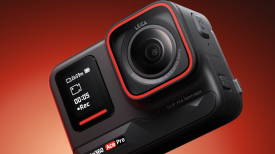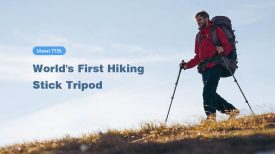Interview by features editor Mat Gallagher:
Cameraman Jerry Ricciotti and DP Jake Burghart travel the globe to film some of the biggest conflicts, most hostile environments and most hair-raising scenes for the HBO series Vice. I spoke to them about Vice’s style, shooting in extreme conditions and the team’s camera of choice, the Canon C300.
Where are you at the moment?
Jerry Ricciotti: We’re in Benghazi, Libya right now; we’ve been in Libya for six days. We came to Benghazi pretty last minute, two days ago, so, this is our second night or third night here I think. It’s been fun. We’ve been doing a story for Vice.com and maybe for the HBO show. It was a little exciting getting over here and not knowing – with all the clashes and all the police and military – what we would see, but we’ve largely been pretty safe, so it’s been good.
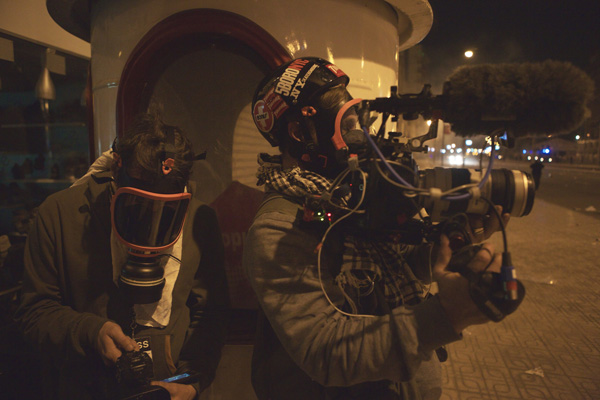
Photo: Jerry Ricciotti
Tell me a little bit about Vice, my impression is that it’s an extreme documentary?
JR: Vice is a little ambiguous because the production company that creates the show is named Vice, but also it’s a magazine and media entity itself. So Vice, on HBO, is the name of the show and yeah, I think [extreme documentary] would be a fair assessment of it; it’s a news magazine show, focusing on a younger demographic, telling stories that are a little bit different, stories that might not get covered on the nightly news and, certainly for Americans, [it’s] something that we don’t see in many of our news outlets.
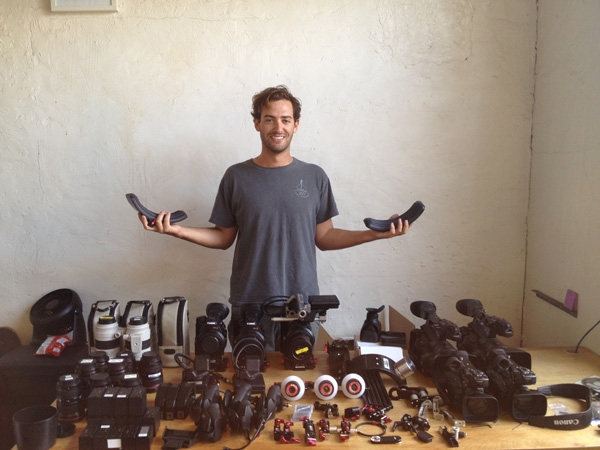
Photo: Jake Burghart
What cameras do you shoot on?
JR: Primarily the Canon C300, and we always go out with a Canon 5D. We first started working with the XF305 and the C300 but it didn’t seem to be a great fit – It wasn’t as good a complement as we hoped, so we started using the 5D. The image from the XF305 matched nicely, it was just the size. Having the full frame and interchangeable lens options of the 5D made it a better second camera. We also always go out with a Canon XF105 and GoPros.
Why did you choose the C300?
Jake Burghart: We got the cameras pretty early on. I shot the Sebastian Tellier video for ‘Russian Attractions’ on the C300 and shot the underwater scenes on a 5D MkIII. I thought the two worked well together and would make a great pair for us in the field.
The C300 almost chose us. There really isn’t another camera in its class. The AF100, FS100, even the F3, none of these cameras can actually meet broadcast standards without using an external recorder. Shoulder-mount ENG cams are basically dinosaurs and just an aesthetic I’ve never been interested in. Then, if you look the other way, Alexa is obviously out of our budget, but even still, that thing would have broken our backs in the field. Same with an Epic, and I can’t imagine being all filthy and covered in mud trying to access a touch screen menu to close down my iris a stop. The Red Scarlet has the same problems. Touch screen is not something I’m ready to deal with. When you add in storage and battery life, you just can’t beat a C300 for what we’re doing. I love shooting on an Epic in a more controlled environment – the picture, the latitude, all amazing – but for doc shooting I can get 300 minutes of accurate, to the minute, battery life out of a single Canon battery that I can wrap my fist around. With two 64GB CF Cards, I can shoot for over 300 minutes straight. I rarely shoot more than that in a day, which means I don’t wrangle cards till the end of every day. That completely eliminates a job in the field, making our crew that much smaller. I’d love to see another super 35mm sensor camera meet those storage and battery specs while shooting at 1080 at 50MB/s in a log gamma. It would be great to have options but even if Sony steps up their FS100 to meet that, they can’t compete with the native glass that comes with Canon. Using Canon zoom lenses on the C300 means iris control is on your handgrip, and my focal distance and focal length are on the screen. I’m changing shots and exposure without taking my eye off the screen or my hand off the grip.
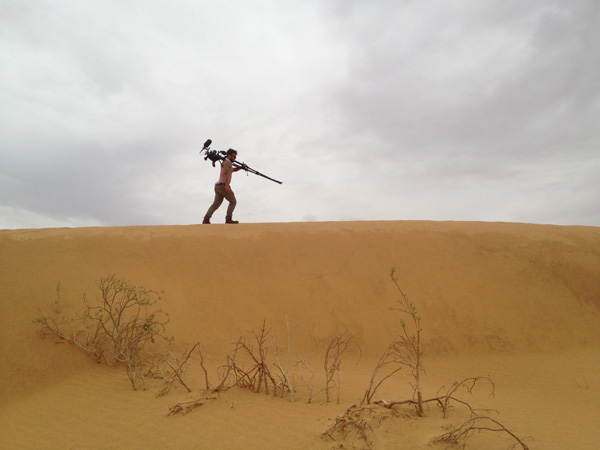
Photo: Jerry Ricciotti
Have you pushed these cameras to their limits?
JR: We didn’t really know the durability of it, so we figured out what it can and can’t do from the nature of our shoots, which are in some pretty extreme terrain – a lot of outdoor work, hiking, on boats, all that sort of transit stuff. What is typical in production [in general], we do with a smaller team and, for me, a much faster pace and much further out.
JB: We shot with the camera hanging out of helicopters in the freezing Russian winter and spent days in the Sahara during the middle of the summer. We suction-mounted it to trucks in West Africa, hung it out of boats in the Maldives, ran it nonstop on way too many 18-hour days in 90 percent humidity, covered the thing in oil, sand, and grime, mounting extra parts anywhere that would take them. The camera stands up to just about anything.
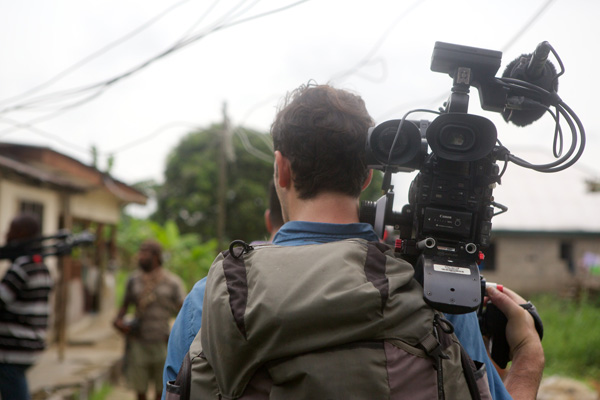
Photo: Jake Burghart
I take it most of your shooting is handheld, run-and-gun style shooting?
JR: Yeah, it has to be, handheld, exactly, run-and-gun. You’re waking up with the camera in the morning and you don’t put it down until the night. We have to eat with it. So having a solid shoulder rig and nothing too big is kind of important. We don’t really bring sliders or glide cams with us on too many shoots. We have done, but it depends on the situation. Mostly it’s just a shoulder rig, all day.
What would you say are the C300’s strengths and weaknesses?
JR: Strengths – definitely its ability to push ISO and the image quality when the gain does come into effect; it’s kind of a pleasant look. Even two years ago with the AF100 I wouldn’t have even thought of not using an on-board light. I’m always finding myself dealing with natural light so, for us, the advantage of that is huge. Basically being able to see in the dark.
I like how easily it can be broken down to almost a camcorder size. When you strip down to just shoot out of the viewfinder, it’s a nicely balanced camera at its smallest. Then of course it’s really upgradable, too. We end up adding a lot of things for shoots, so, ergonomically and just practically, having all the buttons and the menu options available, for me, is just great. The weather proofing of it is great, too. I’ve been really happy being able to take it [into all sorts of environments].
JB: Outside of the size – storage, battery and glass strengths that I’ve already pointed out. The low light capabilities are off the charts. We shot in existing light on the Niger Delta one night. All we had was a moon, the gas flares in the distance, and one red LED. The scene looks amazing and you would have killed it by lighting it. So many times I don’t have to break a scene to add light. I can just crank the ISO and know it’s still going to look good.
The camera needs to be able to do 60fps at 1080. I know it’s possible. Even if you had to go down to 35MB/s it would be better than having to do 720. Even if it did 48fps I’d be happy. I know it’s possible, Canon is just holding out.
The mounting point on the LCD is weak. It gets loose and can’t be tightened. That’s the biggest drawback. If you try to put a shotgun mic on the supplied shock mount, it will definitely loosen that LCD mount point, and you’ll have a hard time keeping your horizon straight using the LCD. Also the handle only has one contact point, which I don’t like. I’ve swapped out to a Movcam handle with four points of contact. I hate that you can’t separate the XLRs and the LCD. We always need XLRs, we don’t always need an LCD. I’d love to see an artificial horizon in the LCD like on most of Canon’s DSLRs.
The hardest part about rigging the camera has been a working EVF. The one on the camera is pretty much useless. The LCD is great, but there is no good solution for a loupe. The (Dietygear) Mira is maybe the only one, and while it’s really nice it’s too heavy for that weak LCD mount point. It doesn’t flip up easily either. If you use a third-party EVF like the Kinotehnik or Alphatron, you still need the LCD to keep the XLRs, and now you don’t have your waveform monitor (which I think is a must when shooting log). You also don’t have the easy push button magnification on your grip. Sony has been good about making their own loupes and putting them in good spots, I’d like to see Canon follow suit.
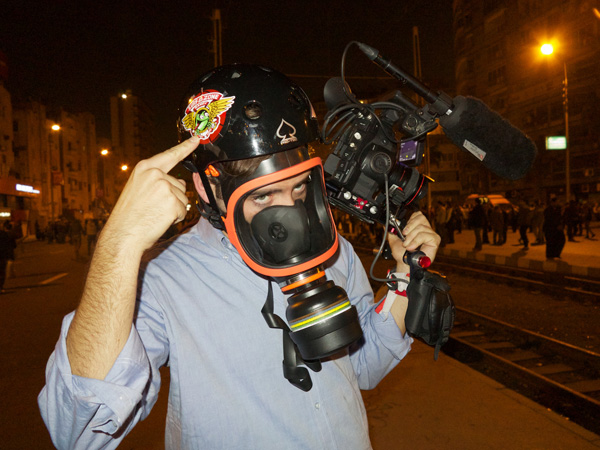
Photo: Jake Burghart
JR: Yeah, the monitor situation has been the one thing that’s been a constant, sort of, game I play before I go out on a shoot. In bright light you really kind of need one, the LCD just barely gets by and so I bought a Kinotehnik EVF, which I was really happy with on the 5D but moving on to the C300, it’s just okay. I’m not completely happy with it. The HDMI out is a major issue, I get nervous it’s going to break – luckily it hasn’t, knock on wood – and then the AA batteries die pretty often. It’s nice to have an extra cartridge when they do, but they die so, I bought the Deitygear Mira, and I don’t like it. It’s so big that it backs up against the underside when you have the LCD flipped open and down, sort of the typical way you have it on a shoulder rig. It jams right into the back of the XLR inputs, so I returned that, and I didn’t even bring one on this shoot. I’ve just been using the cameras EVF, and I’ve actually found that turning up the backlight setting on the LCD made a big difference shooting in daylight. With that, peaking and toggling with the magnification I’ve been able to make pretty accurate exposures and I’ve been able to keep everything focused without too much trouble. But I’m still searching for [a good EVF], that’s definitely the thing that I still can’t figure out.
What other gear are you using?
JR: Typically the Litepanel Micro is the only light we bring with us. We use all Canon lenses on the cameras. Our equipment manager Jaime Chew started calling them the ‘three wise men’: 24-70mm f2.8, 16-35mm, and the 24-105mm. I also bring a 70-200mm f2.8 and I have a doubler for that, which I find myself not using that often.
JB: I have a personal set of Zeiss Distagon primes that I use for interviews, and really low light. But the 16-35mm is my go-to lens. For sound we use Lectrosonic lavs, Sennheiser shotguns, and when we have a sound guy we do a Sound Devices eight track. We like to run a lot of wires and keep booming to a minimum. Nothing blows intimacy like a boom in your face. We light interviews back home but in the field keep it pretty minimal. The Litepanels are for a worst-case scenario, but they generally look pretty terrible.
I’d love to see a working bus-powered four-slot Thunderbolt CF reader. We had a Sonnet version that was fast, but it had too many connections, was too fickle, and too fragile. Now we just use several USB3.0 readers at once.
Do you think 4k would be an advantage to your shooting? Is there any talk of moving to 4k, or is it just not necessary until the networks ask for it?
JB: Right now I can’t see any reason for us to use 4K; too much processing and space. It would make the cameras too bulky, and just bring up too many problems. I really can’t see any of the benefits outweighing that stuff for a long time.
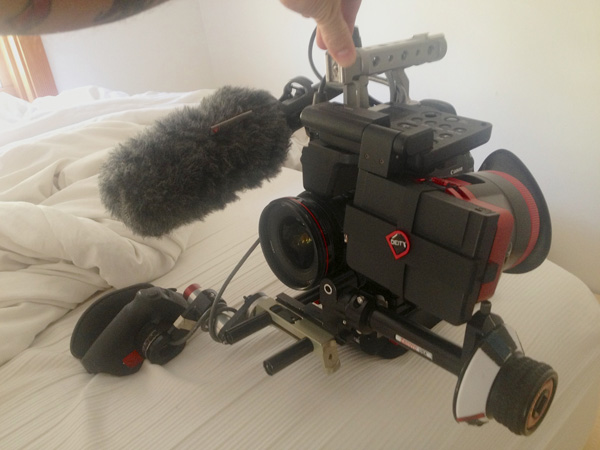
The Zacuto recoil lite puts the camera right on his shoulder for better weight distribution. The extended follow focus sits out past the LCD screen, which has the Diety, Miro Loupe. On the front is the custom handgrip offset made by Abel Cinetech. His shotgun is mounted off to the side, so the camera doesn’t get too tall. Photo by Jake Burghart
What is the shoulder rig that you use?
JB: We try to keep moving, stay off the tripod as much as possible. Everyone has their own shoulder rigs, I like to keep mine light and tight. It’s combo of Zacuto, Movcam, and some custom stuff.
JR: I have a Redrock micro cage, with just the rails, and an offset grip that sits on the rails. That’s basically it for me. Like I said, just having to be so minimal with it, I put my lavs on the back of the rails on Velcro, behind the battery. Sometimes, depending on my setup, if I’m using the EVF, I’ll actually put the LCD and the XLR back there also, which is as much of a counter weight as I’d ever need. Jake’s is even more minimal. I used to use a Zucato shoulder pad also, but having seen him go without it, I decided to get tough and go without it too and just put the rails on my shoulder all day. I’ve got a nice little knuckle in my collarbone through that but it does help with weight.
Give me an example of some of the situations you’ve been in with the cameras that really pushed them to their limits?
JR: We went up the Niger River delta in Nigeria a couple of months ago, to do a story about oil pirates. These guys continue to break into Shell Oil’s pipelines across the delta where they live. They’ll take the oil out of the pipelines and build these large, basically like moonshine distils, where they refine oil themselves. We weren’t sure if we’d have power there so we brought three to four days’ worth of batteries and cards, and camped up there to go out and find these guys. And we did. We found them in the middle of the night, so we shot with a small light panel and a shoulder rig on a Panga Boat as we sped along the river, doing pieces to camera the entire way as we looked for the indication of oil pirates, which are big plumes of smoke flaring from their oil stills.
All the time we shot on the 85mm f/1.2, which sometimes we’ll bring if we know we’re going to be in low light situations a lot. Shooting on an 85mm at f/1.2 on a moving boat is a not the easiest thing to do but the footage came out great, it’s really steady and the audio sounds good on a Lav, and the shotgun with fuzzy did a really good job picking up the host’s audio.
Once we got there, we had to walk in a foot of sludge, which is basically a combination of mud and oil that had been discarded by the guys on a daily basis. They’ll refine gallons and gallons of oil but a lot of that gets discarded around them, so they’re throwing this oil out all over the place. You’re standing in big knee high rubber boots and as the oil is being refined it’s generating a lot of smoke. It’s really a dangerous environment because that smoke can catch fire and the whole place can go up in flames. Of course, you’d like to have a tripod but you can’t, so you find yourself kind of balancing with one hand out trying to keep your balance and the other hand shooting as you move across a pretty explosive terrain. And the whole time monitoring audio and pulling focus, so I was really happy with the camera. I don’t think it would have been a situation that a camcorder would have really shined in. You didn’t need a heavy rig on your shoulder and you didn’t have to look through it all the time. The precision focusing and the low light capabilities meant it was the perfect camera for the job.
That was a pretty built up rig but before that we were in Egypt in protests. We were pretty lucky to get right to the front line of the protests, which turned pretty violent with the cops shooting rubber bullets at kids and them throwing molotovs back, and tear gas. You’re wearing a gas mask, looking through an LCD. Actually what I had done is, I’d shot two different riots in Egypt, one time I had an LCD, a follow focus and a shoulder rig, and the second time I just had the 24-105mm, looking through the eye piece. Physically you just want a camcorder, something pretty low profile that can zoom far and has pretty good image stabilisation. I was really proud of the stuff that we shot. I felt like I was still shooting something beautiful, like snapshots of action, so that was kinda nice.
Do you find when the C300 is broken down it can work to your advantage in that it doesn’t look too imposing?
JR: Yeah, we did some hostile environment training and the big thing he showed was silhouettes. You don’t think about it until you’re in a place like Benghazi but when you have a large camera on a shoulder rig it looks like an RPG. A smaller camcorder-type camera isn’t as imposing in touchy situations. I’m actually really happy with how small it gets. Especially if you have a small lens on it, like an 85mm or something. It’s pretty low profile. I’ll bring a Rode mic too, just a little DSLR one that works on the C300 as well.
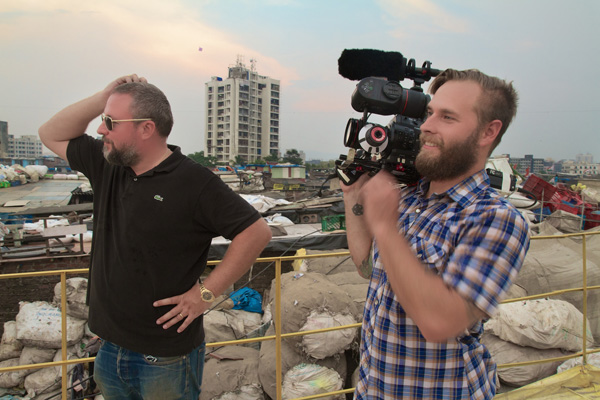
Photo: Brendan Fitzgerald
Can you say what you’ve got coming up in the future?
JB: Season two is getting started pretty much now.
JR: I’m going straight from Libya to Hawaii. I have a couple of other Middle Eastern shoots. We’ll definitely spend a lot of time in Asia, covering more civil unrest, and you can probably assume we’ll see Egypt and Turkey again.
VICE launched in 1994 as a punk magazine, and has expanded into a multimedia network, including Vice.com; an international network of digital channels; a television and feature film production studio; a magazine; a record label; and a book-publishing division.





